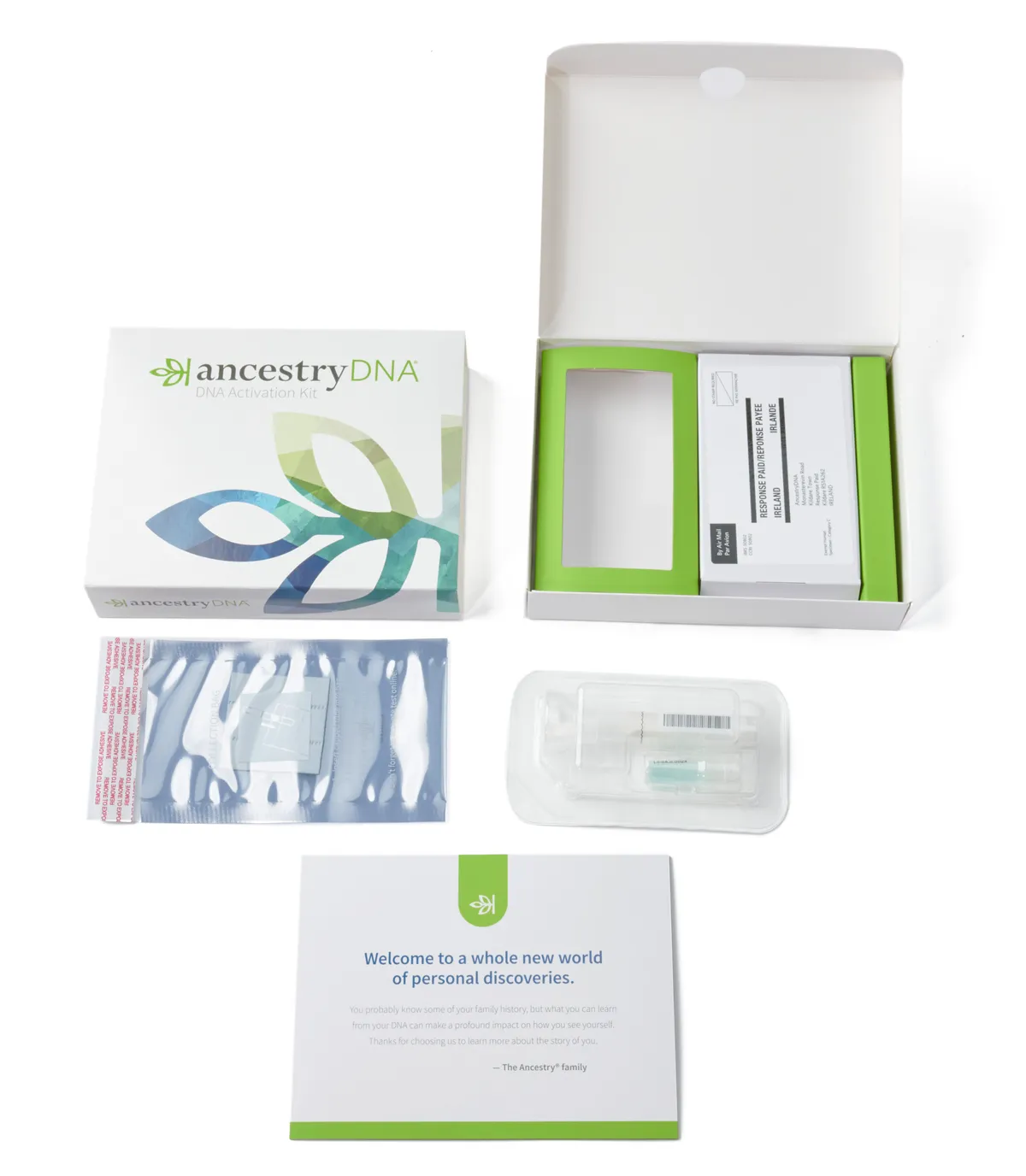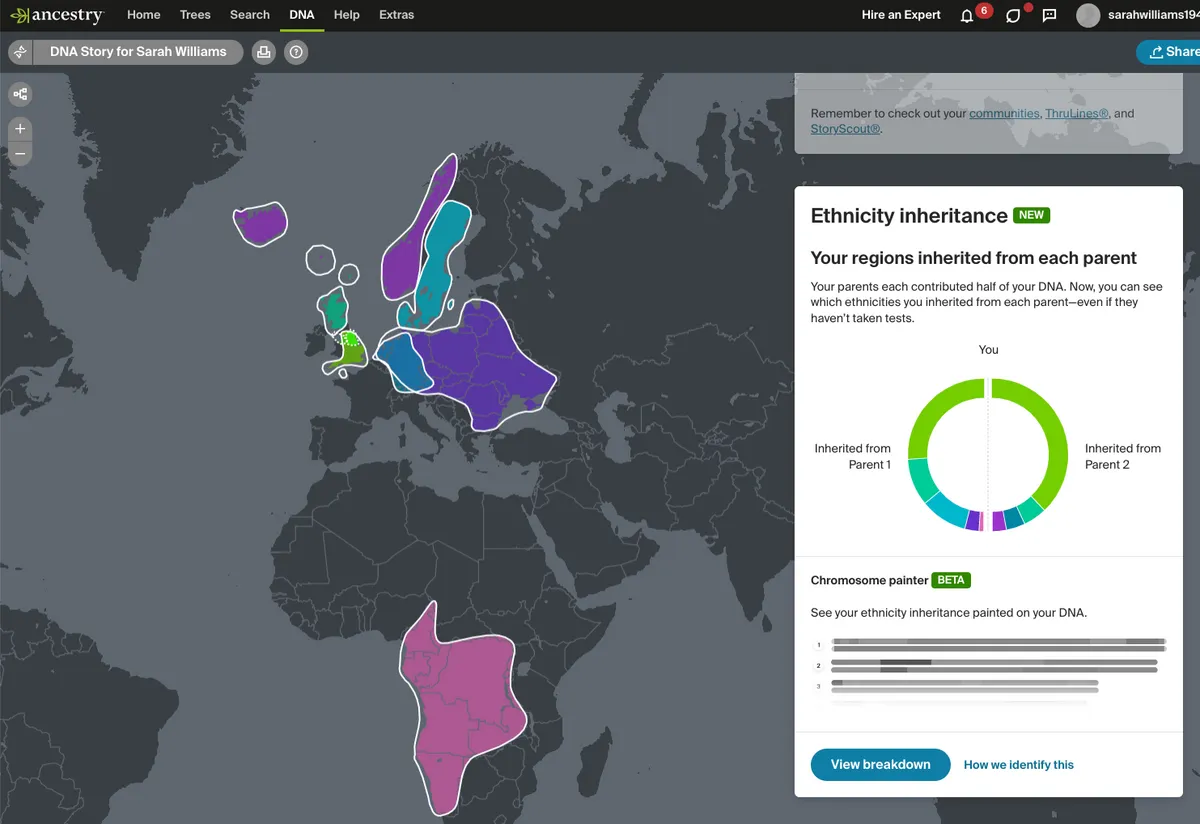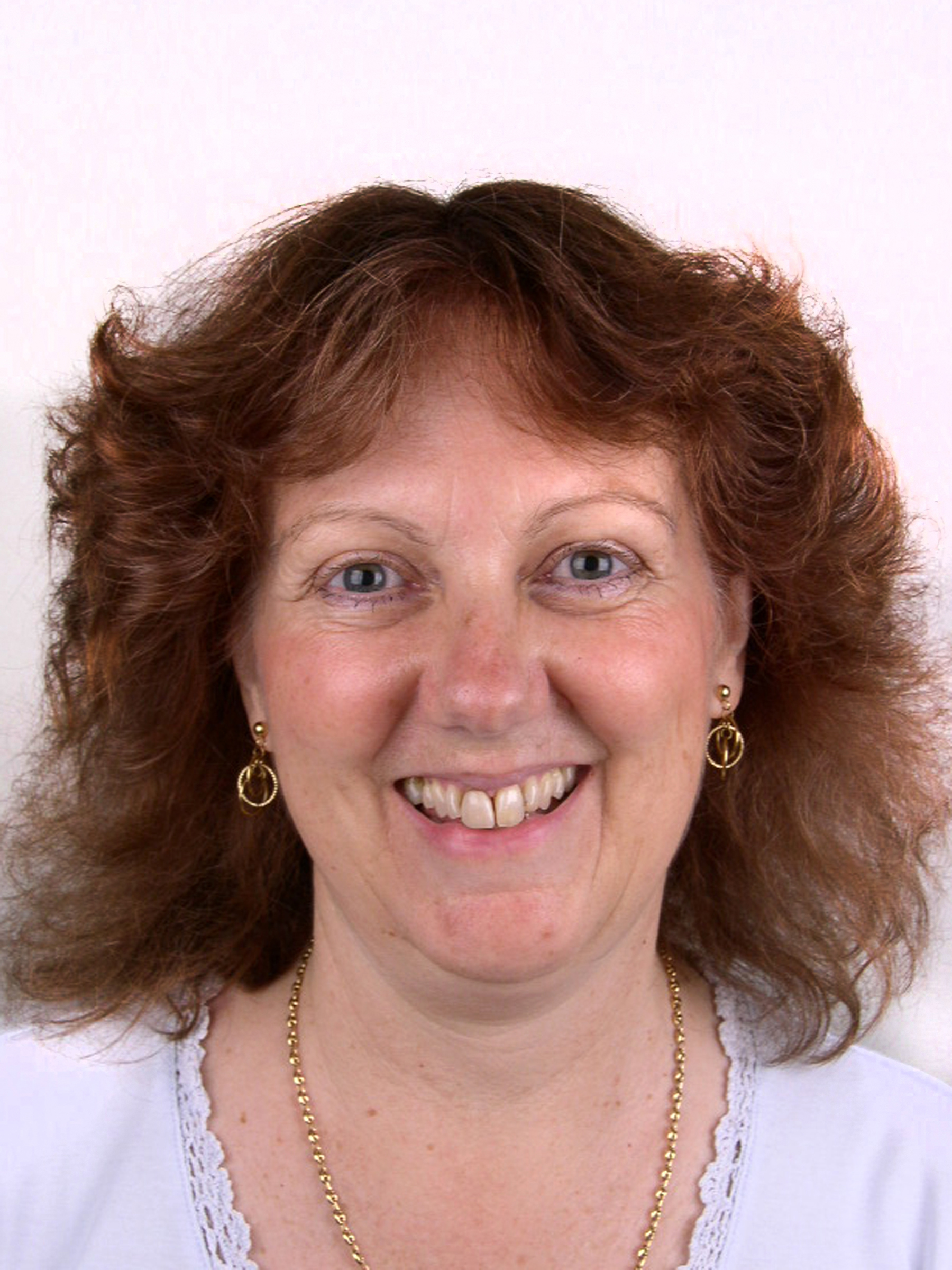Read our review of the best DNA test kits
AncestryDNA has been responsible for taking DNA testing mainstream, and they now have the world’s largest autosomal DNA database of over 21 million people. The DNA test benefits from an easy-to-use interface and good integration with family trees. Sophisticated algorithms provide the most accurate relationship estimates. ThruLines and Common Ancestor hints make it easy to identify how you are related to your DNA matches and the new SideView technology splits your DNA results by parent.
Your results will include biogeographical details broken up into over 1500 global regions but there is also a feature called 'Genetic Communities' which can pinpoint your origins to specific regions within countries with a remarkable degree of accuracy. For those wanting more detail about where in the UK their genetic inheritance comes from, there are plenty of regions and sub-regions giving granular detail of where your more recent family is from.
If you pay extra for the traits reports you can find out more about 38 traits covering behaviour and personality, nutrients, fitness, sensory characteristics and appearance. It's a bit of fun but won't give you much insight into yourself that you probably didn't know already.
A subscription is required to access all the features and to view the full trees of your matches. The lack of a chromosome browser and matching segment data is a disadvantage for advanced users who are interested in chromosome mapping. You will also need an Ancestry subscription if you want full access to the family trees that other users connect to their results as well as to get the most out of ThruLines and Common Ancestors and to access the genealogical records.
Finally, Ancestry is one of the only DNA testing companies that doesn't let you upload your DNA test results from a different company to their database, so if you want to benefit from the connections you may make, then you have to test with them.
Buy now from Ancestry

AncestryDNA test product specifications
- Types of DNA test kits available: A single autosomal DNA test available either as an ancestry-only test or an ancestry and traits test.
- Cost of test: £79 for the AncestryDNA test; £94 for AncestryDNA and traits. Traits can be purchased as an add on for £15.
- Shipping: £10. Includes return postage.
- Database size: Autosomal DNA database of over 21 million.
- Biogeographical ancestry regions: Ancestry provides over 1500 global regions. The Genetic Communities feature pinpoints your origins to specific regions within countries with a remarkable degree of accuracy. Ancestry’s new SideView technology splits your DNA ethnicity results by parent.
- Number of UK and Ireland regions: 8 regions in England and 33 sub-regions; 3 regions in Scotland and 14 sub-regions; 6 regions in Ireland and 88 sub-regions; 4 regions in Wales.
- DNA analysis tools: Coloured dots can be used in conjunction with the shared matches tool to group your matches and identify common ancestors. Confirmed matches can be linked to your tree. Common Ancestor hints and ThruLines do a lot of the hard work of identifying matches for you. New chromosome painter
- Traits: There are currently 38 trait reports available covering behaviour and personality, nutrients, fitness, sensory characteristics and appearance.
- Ancient/deep ancestry: Not available.
- Subscription required to access additional features: An Ancestry subscription is needed to have full access to the family trees to get the most out of ThruLines and Common Ancestors and to access the genealogical records.
- Can you upload DNA test results from other companies to the database? No.

Get more from your Ancestry DNA test
With the big growth in Ancestry's DNA database most people are finding that they are getting lots of good DNA matches, sometimes with second cousins or closer, right from the outset. It is always best to focus on your top matches, which effectively means those that Ancestry predicts to be related to you as fourth to sixth cousins or closer. If your ancestry is predominantly from the UK you will probably have between 200 and 500 matches in the fourth to sixth cousin or closer range, and 10,000 or more matches in the fifth to eighth cousin range. People with Irish, Scottish and Welsh ancestry tend to have more matches than those of English ancestry. This is partly down to more inter-relationships in rural communities; emigration is another important factor.
Jewish ancestry DNA
If you have Jewish ancestry, then you will have a much higher number of matches. This is because of endogamy – the practice of marrying within the same cultural or religious community for hundreds of years. As a result you are related to your matches through many different relationships, and this is reflected in the higher levels of sharing. If someone has completely Jewish ancestry then they may well have more than 150,000 matches, including over 30,000 that are located in the fourth to sixth cousin or closer range.
Assigning DNA matches to your family tree
The process of assigning matches to your tree is much easier if you have done extensive research into all of your ancestral lines going back for about five or six generations. It also helps if you have researched not just your direct ancestors but also all the collateral lines. In genealogy we are mainly focused on taking our trees further back in time, but for DNA it really helps to document the descendants of ancestors right down to the present day because these are the names that will be showing up in your match list. If you recognise the surname you’ll probably be able to work out immediately how you’re related.
Understanding Ancestry's ThruLines and Common Ancestors
Ancestry has some very useful features, such as ThruLines and Common Ancestors which take a lot of the hard work out of the process of identifying common ancestors by showing the potential pathway through which you are related. However, in order for these features to work you need to upload a tree to Ancestry and link it to your DNA account. The tree must be either public or private and searchable. Names in private and searchable trees appear in search results, but your matches will need to contact you for full access to the tree. Not everyone likes to share their research on Ancestry, so if you prefer you can share a skeleton tree with basic names and dates but no detailed sources.
While many of Ancestry’s DNA features are free, you will need to maintain a subscription to access additional details and in particular the detailed family tree information. If your match has uploaded a family tree you will be able to see a five-generation preview tree, which provides the names along with the birthdates and death dates, but without any locational information. If you have a subscription you can click through and access the full family tree, which may go back many more generations.
Introducing Ancestry SideView and Ancestry Chromosome Painter

A new tool that has recently been added to AncestryDNA is SideView. This uses Ancestry's vast database and users' family trees to work out which DNA you have inherited from each parent. Ancestry SideView does not tell you which parent each set of DNA comes from, you have to try and work that out yourself by looking at the biogeographical information and comparing to known matches. A basic chromosome painter has also been added which lets you see where your ethnicity information sits on each chromosome. It's not as advanced as DNA Painter but it is a helpful way to see your ethnicity inheritance. Longer segments suggest that your connection to a particular region is more recent.
How to interpret DNA matches on AncestryDNA
Ancestry provides information about the predicted relationship and the amount of DNA shared measured in centimorgans (cM). In general, the higher the total cM count the closer the relationship. Another important way of determining relationships is to look at the frequency of a segment of DNA in the population. However, it is important to note that not all of the DNA that we share with other people is shared because of a recent genetic relationship. We can share DNA because we all descend from the same population or the same ethnic group. If a segment is shared, for example, by large numbers of people from Yorkshire or Ireland then it is likely to date back a very long way, whereas if a segment is of genealogical relevance then it is only going to be shared by a few cousins or close relations.
Ancestry has a proprietary algorithm known as Timber which is applied to all matches that share 90 cM or less. Regions of the genome where there is significant overmatching are downweighted, and the revised cM total will give a more reliable estimate of the actual relationship.
Ancestry now also provides information about the number of segments shared and the length of the longest segment. In general, matches that share more than one segment will be easier to assign and of more recent origin. If you only share a single segment of DNA then the match could potentially trace back 10 generations or more. However, there are sometimes discrepancies with the number of segments. I’ve found examples where one of my parents shares a single segment with a match but the same person shares two segments with me.
Why centimorgan segment lengths matter
Knowing the length of the longest segment is going to be most useful for people from endogamous populations, and can help to determine which of their matches they are actually related to with longer segments being more indicative of recent relationships. For example, a match who shares 98 cM across seven segments with a longest segment of 31 cM is going to be considerably more relevant than a match who shares 98 cM across 11 segments with a longest segment of 16 cM.
You can also look at the average segment size. A 98 cM match with 11 segments has an average segment size of under 9 cM, and these small segments are likely to be the result of background relatedness in the population or connections through multiple distant ancestors rather than a recent family relationship. For endogamous populations it is generally recommended to focus on matches that share a longest segment of 20–30 cM.
How to find connections with DNA matches
However, don’t expect to be able to identify connections with all of your matches. Every match over 30 cM is generally worth pursuing. Matches in the 15–30 cM range may share a common ancestor, but many matches in this range will be very distant and can’t be identified. As the amount of shared DNA starts to decrease, it becomes more difficult to assign relationships and there is an increasing chance that the matches will be false. If you’ve tested both of your parents then you will find that you have a significant number of small matches that don’t match either your mother or your father.
If you have a match with a name you recognise, the first thing to do is to look at the total cM shared. You want to check that the amount of DNA shared is consistent with the proposed relationship. If you click on the total cM shared, you can see a probability table showing the range of possible relationships and the percentage of people falling into each category. If the relationship falls outside of the expected range then you may be matching through a half relationship (for example, a half second cousin instead of a full second cousin).
Matches are easier to assign once you have identified a number of your known cousins, particularly at the second- and third-cousin level. It also helps if you can test known close relations. I’ve been able to test both of my parents, which means that my matches over 20 cM are assigned to the maternal and paternal sides. Remember that siblings will get a different representation of your ancestral DNA, and will get matches that you don’t have.
If you have a match with an unknown cousin, check the Shared Matches to find out which matches you have in common. This group of shared matches forms a cluster who are all matching you through one particular section of your family tree. Compare the family trees, if available, and see if you can identify a common ancestral couple for the cluster.
Use Ancestry’s system of coloured dots to sort your matches into groups. Resolving a cluster will often require a certain amount of family tree building, either back in time to identify the common ancestor or forwards in time to work out their relationship to you. Don’t worry about adding meticulous sources to your tree. You can construct a quick, basic family tree and tidy up the connections later.
How to filter your matches on AncestryDNA
There are a number of filters that allow you to sort your matches in different ways. You can filter by unviewed matches, common ancestors, matches you have messaged, matches with notes, matches with trees, shared DNA and groups. If you click on the ‘Shared DNA’ filter you can see how many matches you have in each category and search for matches in a custom range. You can also combine the filters to search, for example, for distant matches with trees, and sort matches from newest to oldest or from closest to distant.
You can add notes to your matches where you can record information about the match, such as the confirmed relationship and the names of the common ancestors You will save a lot of time if you make notes when you first view the match, because it’s so easy to forget the details when you go back to revisit the match at a later date.
It’s easier than ever to work with your matches, and we are seeing many thrilling success stories. We can look forward to more exciting developments in the months to come as Ancestry rolls out additional features to help us group and sort our matches.
